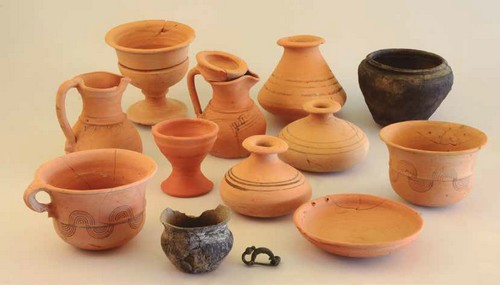
Artisan neighborhood Carralaceña: pottery masters

Panorama and location of the kiln of Carralaceña
An
“Greater-Pintia” extends to the right bank of the Duero River, an area known as Carralaceña, where the artisan quarters and workshops were located. It was connected to Las Quintanas by a natural ford.
This neighbourhood probably emerged as an extension of the residential area of Pintia and as a consequence of an increase of the demand of ceramic products. The risk of fire was reason enough to keep the residential area away from any activity that involved the use of fire and also may have included a direct water supply.
Carralaceña occupies around nine hectares and this sector had many functional areas: a residential area with it´s own necropolis (located in the higher platform of the riverbank) and the production area as such (located in the lower part of the riverbank) closer to the river.
The structures found here are the remains of a pottery workshop that operated during the final two centuries B.C. and the cross of Era. It produced the ceramic objects that were used for of Pintia´s daily life.
The archaeological work developed until now in this area has provided us with very diverse data, although all the information has some link or relation to pottery production, being the most abundantly found pottery the wheel-made ceramic shards.
However, the most significant archaeological evidences found here so far, are the structures of three kilns used for the wide range of Pintian ceramic production. Furthermore, areas to discard defects were also uncovered. Nonetheless, the most impressive of the three kilns (due to it´s size and preservation) is kiln 2, composed by a double chamber with a circular shape that measures around 4,5 meters in diameter with a vertical chimney and an horizontal passageway or praefurnium.

Vaccean pottery (tomb 98 of the necropolis of Las Ruedas)





